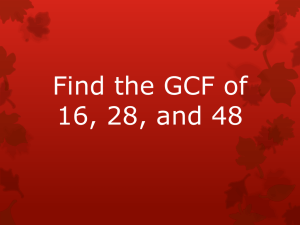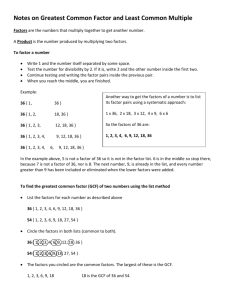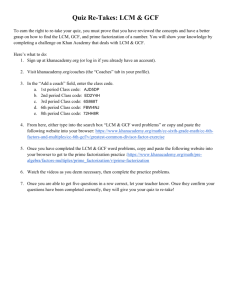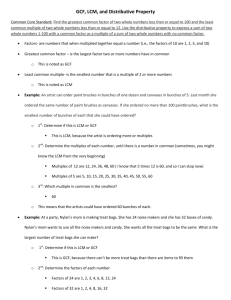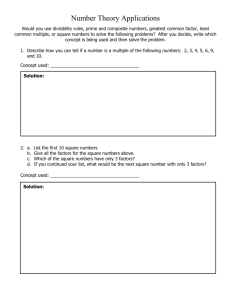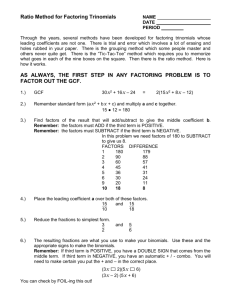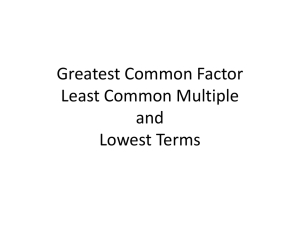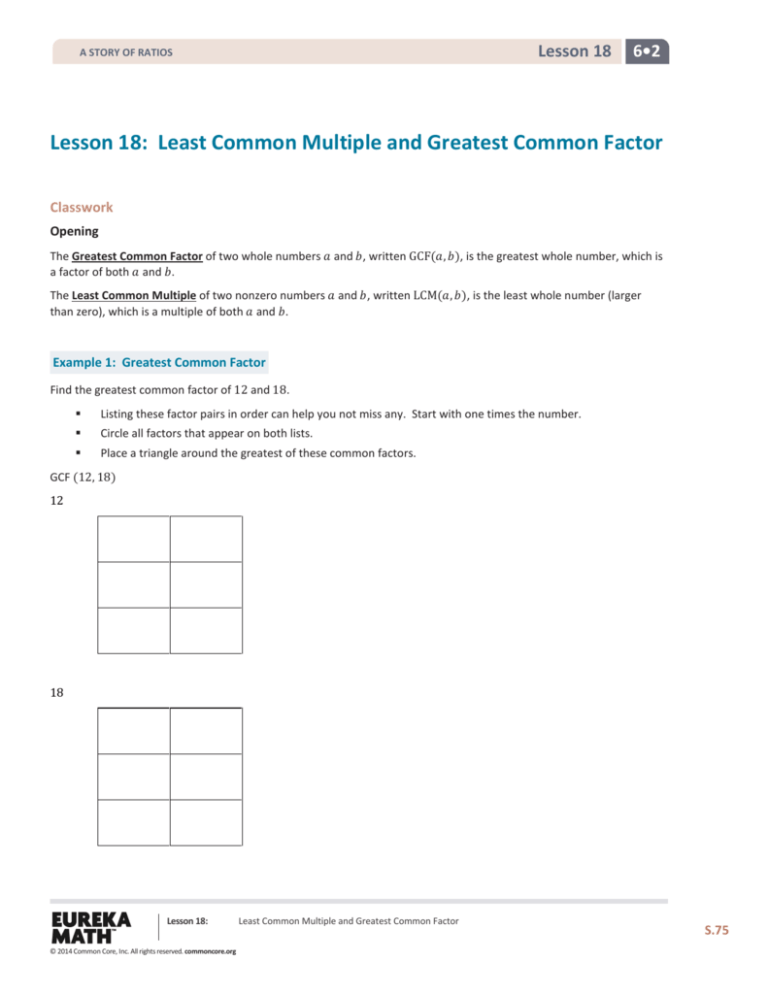
Lesson 18
A STORY OF RATIOS
6•2
Lesson 18: Least Common Multiple and Greatest Common Factor
Classwork
Opening
The Greatest Common Factor of two whole numbers 𝑎𝑎 and 𝑏𝑏, written GCF(𝑎𝑎, 𝑏𝑏), is the greatest whole number, which is
a factor of both 𝑎𝑎 and 𝑏𝑏.
The Least Common Multiple of two nonzero numbers 𝑎𝑎 and 𝑏𝑏, written LCM(𝑎𝑎, 𝑏𝑏), is the least whole number (larger
than zero), which is a multiple of both 𝑎𝑎 and 𝑏𝑏.
Example 1: Greatest Common Factor
Find the greatest common factor of 12 and 18.
Listing these factor pairs in order can help you not miss any. Start with one times the number.
Circle all factors that appear on both lists.
Place a triangle around the greatest of these common factors.
GCF (12, 18)
12
18
Lesson 18:
© 2014 Common Core, Inc. All rights reserved. commoncore.org
Least Common Multiple and Greatest Common Factor
S.75
Lesson 18
A STORY OF RATIOS
6•2
Example 2: Least Common Multiple
Find the least common multiple of 12 and 18.
LCM (12, 18)
Write the first 10 multiples of 12.
Write the first 10 multiples of 18.
Circle the multiples that appear on both lists.
Put a rectangle around the least of these common multiples.
Exercises
Station 1: Factors and GCF
Choose one of these problems that has not yet been solved. Solve it together on your student page. Then, use your
marker to copy your work neatly on the chart paper. Use your marker to cross out your choice so that the next group
solves a different problem.
GCF (30, 50)
GCF (30, 45)
GCF (45, 60)
GCF (42, 70)
GCF (96, 144)
Lesson 18:
© 2014 Common Core, Inc. All rights reserved. commoncore.org
Least Common Multiple and Greatest Common Factor
S.76
Lesson 18
A STORY OF RATIOS
6•2
Next, choose one of these problems that has not yet been solved:
a.
There are 18 girls and 24 boys who want to participate in a Trivia Challenge. If each team must have the same
number of girls and boys, what is the greatest number of teams that can enter? How many boys and girls will be on
each team?
b.
The Ski Club members are preparing identical welcome kits for the new skiers. They have 60 hand warmer packets
and 48 foot warmer packets. What is the greatest number of kits they can prepare using all of the hand and foot
warmer packets? How many hand warmer packets and foot warmer packets will be in each welcome kit?
c.
There are 435 representatives and 100 senators serving in the United States Congress. How many identical groups
with the same numbers of representative and senators could be formed from all of Congress if we want the largest
groups possible? How many representatives and senators are in each group?
d.
Is the GCF of a pair of numbers ever equal to one of the numbers? Explain with an example.
e.
Is the GCF of a pair of numbers ever greater than both numbers? Explain with an example.
Lesson 18:
© 2014 Common Core, Inc. All rights reserved. commoncore.org
Least Common Multiple and Greatest Common Factor
S.77
Lesson 18
A STORY OF RATIOS
6•2
Station 2: Multiples and LCM
Choose one of these problems that has not yet been solved. Solve it together on your student page. Then, use your
marker to copy your work neatly on the chart paper. Use your marker to cross out your choice so that the next group
solves a different problem.
LCM (9, 12)
LCM (8, 18)
LCM (4, 30)
LCM (12, 30)
LCM (20, 50)
Next, choose one of these problems that has not yet been solved. Solve it together on your student page. Then, use
your marker to copy your work neatly on this chart paper. Use your marker to cross out your choice so that the next
group solves a different problem.
a.
Hot dogs come packed 10 in a package. Hot dog buns come packed 8 in a package. If we want one hot dog for
each bun for a picnic, with none left over, what is the least amount of each we need to buy? How many packages
of each item would we have to buy?
b.
Starting at 6: 00a.m., a bus makes a stop at my street corner every 15 minutes. Also starting at 6: 00a.m., a taxi
cab comes by every 12 minutes. What is the next time there will be a bus and a taxi at the corner at the same
time?
c.
Two gears in a machine are aligned by a mark drawn from the center of one gear to the center of the other. If the
first gear has 24 teeth, and the second gear has 40 teeth, how many revolutions of the first gear are needed until
the marks line up again?
Lesson 18:
© 2014 Common Core, Inc. All rights reserved. commoncore.org
Least Common Multiple and Greatest Common Factor
S.78
Lesson 18
A STORY OF RATIOS
d.
Is the LCM of a pair of numbers ever equal to one of the numbers? Explain with an example.
e.
Is the LCM of a pair of numbers ever less than both numbers? Explain with an example.
6•2
Station 3: Using Prime Factors to Determine GCF
Choose one of these problems that has not yet been solved. Solve it together on your student page. Then, use your
marker to copy your work neatly on the chart paper. Use your marker to cross out your choice so that the next group
solves a different problem.
GCF (30, 50)
GCF (30, 45)
GCF (45, 60)
GCF (42, 70)
GCF (96, 144)
Lesson 18:
© 2014 Common Core, Inc. All rights reserved. commoncore.org
Least Common Multiple and Greatest Common Factor
S.79
Lesson 18
A STORY OF RATIOS
6•2
Next, choose one of these problems that has not yet been solved:
a.
Would you rather find all the factors of a number or find all the prime factors of a number? Why?
b.
Find the GCF of your original pair of numbers.
c.
Is the product of your LCM and GCF less than, greater than, or equal to the product of your numbers?
d.
Glenn’s favorite number is very special because it reminds him of the day his daughter, Sarah, was born. The
factors of this number do not repeat, and all the prime numbers are less than 12. What is Glenn’s number? When
was Sarah born?
Station 4: Applying Factors to the Distributive Property
Choose one of these problems that has not yet been solved. Solve it together on your student page. Then, use your
marker to copy your work neatly on the chart paper. Use your marker to cross out your choice so that the next group
solves a different problem.
Find the GCF from the two numbers, and rewrite the sum using the distributive property.
1.
2.
3.
4.
5.
12 + 18 =
42 + 14 =
36 + 27 =
16 + 72 =
44 + 33 =
Lesson 18:
© 2014 Common Core, Inc. All rights reserved. commoncore.org
Least Common Multiple and Greatest Common Factor
S.80
Lesson 18
A STORY OF RATIOS
6•2
Next, add another new example to one of these two statements applying factors to the distributive property.
Choose any numbers for 𝑛𝑛, 𝑎𝑎, and 𝑏𝑏.
𝑛𝑛(𝑎𝑎) + 𝑛𝑛(𝑏𝑏) = 𝑛𝑛(𝑎𝑎 + 𝑏𝑏)
𝑛𝑛(𝑎𝑎) − 𝑛𝑛(𝑏𝑏) = 𝑛𝑛(𝑎𝑎 − 𝑏𝑏)
Problem Set
Complete the remaining stations from class.
Lesson 18:
© 2014 Common Core, Inc. All rights reserved. commoncore.org
Least Common Multiple and Greatest Common Factor
S.81


